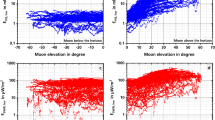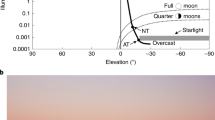Abstract
IT is now well-established that the illumination of the clear day-sky at high-level stations is almost entirely due to molecular scattering by the atmosphere. The remarkable changes in the character of skyillumination which take place when the sun approaches and gets below the horizon have been the subjects of study of a number of investigators and in recent years, particularly of Profs. Dorno1 and Gruner.2 Some of the phenomena, as for example, the changes of colour and polarisation of skylight and the appearance of the earth-shadow, occur in the clearest of weathers and at such high-level stations that their origin cannot be attributed to anything other than molecular scattering. Gruner has, indeed, shown that the observed changes of colour of skylight when the sun is near the horizon can be explained by scattering by a pure atmosphere.
This is a preview of subscription content, access via your institution
Access options
Subscribe to this journal
Receive 51 print issues and online access
$199.00 per year
only $3.90 per issue
Buy this article
- Purchase on Springer Link
- Instant access to full article PDF
Prices may be subject to local taxes which are calculated during checkout
Similar content being viewed by others
References
C. Dorno, “Himmelshelligkeit, Himmelspolarisation und Sonnenintensität in Davos, 1911 bis 1918”, Veröffent. des Prüssischen Meteor. Instituts, Abhandlungen, Bd. 6, 1919.
P. Gruner, “Beiträge zur Physik der freien Atmosphäre”, Bd. 8, pp. 1 and 120 (1919).
Author information
Authors and Affiliations
Rights and permissions
About this article
Cite this article
RAMANATHAN, K. Intensity and Polarisation of Skylight at Sunrise and Sunset. Nature 118, 337–338 (1926). https://doi.org/10.1038/118337a0
Issue Date:
DOI: https://doi.org/10.1038/118337a0
This article is cited by
-
Dr. K. R. Ramanathan on his sixtieth birthday
Proceedings of the Indian Academy of Sciences - Section A (1953)
Comments
By submitting a comment you agree to abide by our Terms and Community Guidelines. If you find something abusive or that does not comply with our terms or guidelines please flag it as inappropriate.



